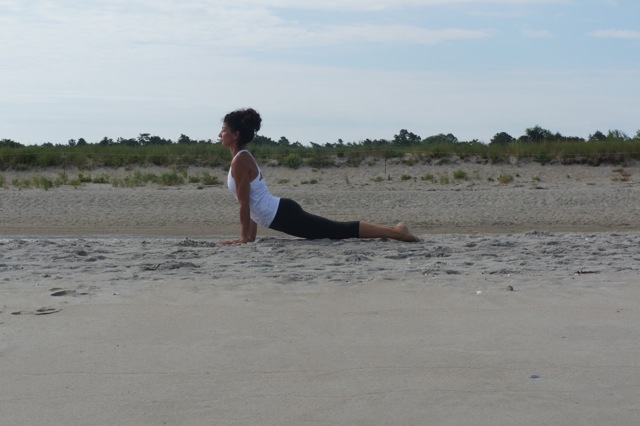
I’ve been teaching classes recently inspired by an anatomical theme. The theme has to do with mobilizing the thoracic, or mid-spine, to get greater space in the chest, move movement in twists and more space in backbends. I’ve been combining the instruction around the spine with instruction around the thighs, encouraging students to spiral their inner thighs back to open up their sacroiliac joint. These 2 actions combined can create more space in backbends like Bow and Wheel.
The other aspect of this theme, which is more of the “mind/body connection” aspect of it, is the idea that because this part of the spine is so tight, and because of it’s placement behind and around the heart (think of the 12 thoracic vertebrae, the ribs and sternum forming the thoracic cage) if we are stiff in that part of the body, we might also be hard or more dull in the area of our heart center. The concept of “protection” when it comes to our heart, our feelings and our thoughts and dreams is certainly something to which we can all relate. We’ve all been hurt, all had an idea expressed shot down, all had the experience of sharing a dream to perhaps have someone discount it. These experiences can create a tendency to hide our feelings, keep our dreams to ourselves and bury our faces in our iphones. Working with this part of the body can feel rather freeing for people and can sometimes re-connect them to feelings they’ve been burying for some time now.
Here are some anatomical instructions you can bring into teaching this kind of theme:
Start by mentioning the theme and acknowledging the stiffness of the mid-spine due to it’s job to protect the heart and lungs and the tightness of the connections between these 12 vertebrae and the ribs;
Mention the tendency to overuse the cervical or lumbar spine, due to it’s greater mobility, to give students a chance to hear this before you take them through the sequence;
Start them on their backs, with their arms in “cactus arms.” This will create a slight bend in the thoracic spine. Have them keep their head down and their shoulder blades pressing into the mat. Instruct to draw their belly into their spine to create length in their lumbar spine. Have them press their feet forward, flexing them, as if they were pressing them into a wall. Then, instruct to roll their inner thighs down, without moving their feet. Ask them if they feel a sense of “broadening” in their low spine as they spiral their thighs down and open through the mid-chest.
Bring them to their feet and have them reach up to the sky. Instruct to turn palms in, spiral inner thighs back and see if that sense of broadening in the low spine happens again.
From there, you can take them through any series of poses that involve twists, primarily. I like to use things like, Upward Dog, Twisting Crescent Lunge, Prayer Twist, Half Moon to Chapasana, Warrior 2, Side Angle, Side Plank with Top Arm reaching overhead, Locust, Bow, Camel and Wheel. I like to work up to a peak pose, be it Chapasana, Camel or Wheel. As I’ve been instructing through every twist the key aspects of moving from the mid-back, protecting the cervical and lumbar spine, lengthening the tailbone towards the heel and keeping uddiyana active, by the time they get to the peak pose, they have more of a sense of the key actions to get into the pose safely and with more integrity.
As the mind/body theme is focused on showing yourself, opening your heart, letting go of protecting your feelings and showing your true self, I like to add in comments that are inspired by these ideas.
Playing with themes in your classes is a great way to challenge yourself as a teacher. Choosing an anatomical theme is a way to reinforce what you know about anatomy and adding a mind/body aspect to the theme is a great way to try to speak from your heart and connect to your students through authentic sharing. This was a large part of what we studied when we were with Tiffany Cruikshank at her most recent training in NYC on sequencing.
Remember, any theme you pick can be reworked in many ways. Just because you commit to a theme does not mean you have to teach the same poses every class. See what inspires you as you practice it and then bring it to class to share.

Trackbacks/Pingbacks